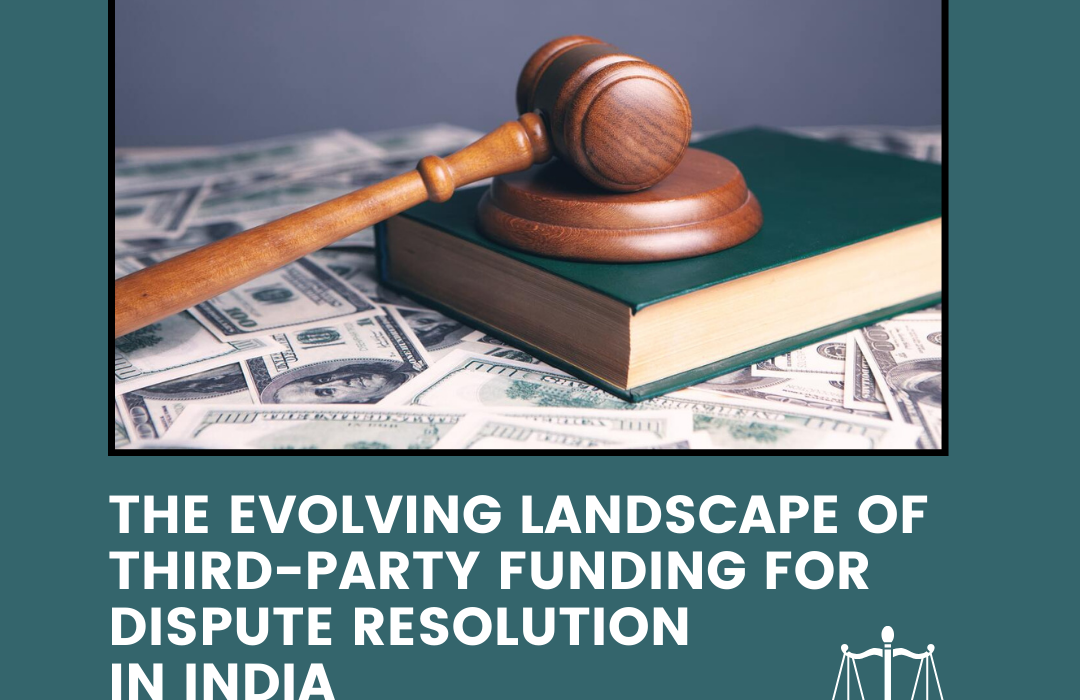THE EVOLVING LANDSCAPE OF THIRD-PARTY FUNDING FOR DISPUTE RESOLUTION IN INDIA
Third-party funding (TPF) refers to an arrangement between a litigant and independent third party for financing the dispute resolution process, wherein it is mutually agreed that in an event of success, the third-party would get a share of the monetary award or damages received by the litigant, out of the dispute resolution process. TPF in dispute resolution process can prove to be an essential tool to promote access to justice by levelling the playing field, at least in terms of financial capabilities of the litigants.
India, where access to justice is a constitutional mandate, presents a unique and promising market for TPF, driven by its rapidly developing economy and increasing sophistication of its legal system. As the country’s commercial activity intensifies, the potential for complex commercial disputes rises, creating favorable conditions for TPF in litigation, domestic and international arbitrations. This article delves into the evolving landscape of TPF for dispute resolution in India, and gives insights on the related business-prudence, juris-prudence, emerging global trends, future prospects and ethical considerations.
Economic Context and Market Potential : India’s economy has been on a robust growth trajectory, with forecasts suggesting continued expansion. This growth has attracted significant investment, resulting in heightened interest from investors in various sectors. As a consequence, the legal system has evolved to accommodate more intricate commercial disputes, which signals good prospects for TPF. As of now, there are only a few companies and crowdfunding platforms operating in the Indian TPF market, while the large global players are yet to establish their presence.
TPF assists in managing the risk of dispute resolution process, as it leverages capital for the enforcement of rights of the litigants, and allows the litigants to utilize their funds solely for core business activity rather than on cost of dispute resolution. From a litigant’s perspective, TPF is a non-recourse finance arrangement with zero cost of capital resulting in increased operating profit and market value without any impact on EBITDA (earnings before interest, taxes, depreciation, and amortization). The litigants get an objective analysis of the dispute from the expertise and experience of the funder, by which winnable claims can be assessed in advance. TPF also discourages deep-pocketed litigants from doing frivolous litigation against unaffluent litigants.
From a funder’s perspective, TPF has immense business potential, as it has a higher ROI (return on investment)thansectors such as private equity and real estate. The investment returns are not subject to vagaries of the market. Investment banks, hedge funds, insurance companies and pension funds can also invest in legal claims as an asset class. Funders may have ready investible capital or may raise funds for specific claims in an ad-hoc manner. Increasingly, funders are leveraging technology to provide for crowdfunding platforms for TPF.
The bottom line is, as a market, India is embracing change and progress. The global TPF Investment Market size is assessed at USD 17.5 Billion in 2024 and is expected to reach USD 67.2 Billion by the end of 2037, growing at around 11.1% CAGR (compound annual growth rate) during the forecast period, i.e., between 2025-2037. With investors generally favoring entering the nation in view of its growth prospects, one can expect that innovative legal solutions will increasingly become mainstream. In these circumstances, the potential for TPF for dispute resolution in India is high.
Legal Framework: Historically, English common law treated “maintenance” and “champerty” i.e., TPF for dispute resolution as both a tort and crime. Indian legal traditions have grown out of, and are founded on English traditions, and the English common law. However, the rule against maintenance and champerty did not form part of the Indian law.
In Ram CoomarCondoo vs. Chunder Canto Mukherjee (1876) the Privy Council watered down the standard of champertous agreements being hit by the public policy principle in common law, and held that such agreements would possibly repudiate the public policy of India in the event that they were inalienably discriminatory, inappropriate and not made with malafide objects of supporting a claim.
This view was subsequently trailed by the Privy Council in Raja Rai Bhagawat Dayal Singh vs. Debi Dayal Sahu (1908) wherein it was held that English law of maintenance and champerty was inapplicable in India.
In B. Sunitha vs. State of Telangana (2017) the Hon’ble Supreme Court of India relied on the decision of the case Mr. ‘G’, A Senior Advocatevs. Unknown (1954) and observed that a personal interest in the outcome of proceedings by the advocate is unacceptable and unequivocally precluded in all the jurisdictions, and the agreements on contingency fee are prohibited in law where an advocate is a party.
In Bar Council of India vs. AK Balaji (2018) the Hon’ble Supreme Court of India reaffirmed the lawful admissibility of non-lawyer third party funding in litigation and recouping the due amount after the outcome of the dispute.
In Jayaswal Ashoka Infrastructure (P) Ltd. vs. Pansare Lawad Sallagar (2019) the Hon’ble Bombay High Court’s has effectively held that law graduates may engage in the business of litigation finance, provided they are not advocates registered under the Advocates Act 1961, and thus can enter into damages-based agreement otherwise barred under the Bar Council of India Rules.
In Tomorrow Sales Agency vs. SBS Holdings (2023) a division-bench of the Hon’ble Delhi High Court, taking a pro-TPF stance, set aside an order of awhich required a third-party funder to furnish security and comply with other interim measures, for the costs of proceedings awarded against the funded party, in an application under Section 37 of the Arbitration and Conciliation Act, 1996.
In addition to the aforementioned judicial pronouncements, certain states have taken steps to acknowledge TPF through amendments to the Civil Procedure Code, 1908. For example, in states of Uttar Pradesh, Madhya Pradesh, Tamil Nadu and Orissa, courts may require security for costs if a plaintiff is financed by a third party.
Despite the absence of an explicit legislative ban on TPF, certain challenges remain for funders and parties. Notably, Indian lawyers are prohibited from providing funding or entering into alternative fee arrangements. Rule 2 (share or interest in an actionable claim), Rule 18 (fomenting litigation), Rule 20 (contingency fees) and Rule 22 (participating in bids in execution, etc.) of the Bar Council of India Rules, 1965 stipulates that advocates in India cannot fund the litigation for their clients. Moreover, endemic delays in the Indian judicial system often result in prolonged recovery times, potentially hindering the realization of awards or decrees.
In March 2023, the Bar Council of India has partially opened up the legal services market through the Bar Council of India rules for registration and regulation of foreign lawyers and foreign law firms in India, 2022 (“foreign lawyer rules”).The foreign lawyer rules allow foreign lawyers and foreign law firms to advise on foreign law and international law in “non-litigious” areas of practice and in international arbitrations. It is noteworthy that the foreign lawyers are not prohibited from providing TPF in any manner, which open new doors for cross-border TPF for dispute resolution in India.
Emerging Global Trends in TPF: Globally, TPF is undergoing significant transformation, influenced by various trends:
- Innovative Risk Transfer Arrangements: Defendants increasingly seek funding that covers not just litigation costs but also the risk of adverse decisions. This has led to the development of financial products, such as After the Event (ATE) Insurance.
- Artificial Intelligence in Decision-Making: AI-driven algorithms are becoming integral in assessing case outcomes and pricing funding risks. Increasingly, funders make data driven decisions that are screened by confidential algorithms to determine the viability of a dispute as investment.
- Portfolio Funding: This approach allows funders to finance multiple class action and representative claims distributing risk across cases and improving funding terms.
- Legislative Sanction: Countries like Australia, Singapore, Hong Kong and USA have recognized and legalized TPF, moving away from outdated common law concepts like champerty and maintenance. India may also follow as it adapts to global trends.
Future Prospects for TPF in India: Looking ahead, several factors may shape the future of third-party funding (TPF) in India:
- Legislative Acknowledgment: Legislative recognition of TPF can provide clarity and boost investor confidence, establishing a more secure environment for funding arrangements.
- Rising Reliance on TPF: As commercial disputes become more intricate, businesses may increasingly turn to TPF to alleviate upfront litigation costs, making it a valuable resource for navigating complex legal landscapes.
- Self-Regulation Models: Adopting self-regulation frameworks similar to other countries could benefit India. Such models would regulate funder involvement in litigation strategies, mandate funding disclosures, and create guidelines for confidentiality and legal fees.
- Foreign Investment: Regulatory amendments allowing foreign capital into domestic TPF markets could further enrich the funding landscape, fostering competition and innovation within the sector.
Ethical considerations in TPF for dispute resolution in India: Clearly identifying the roles of participants in financing arrangements, ensuring transparency in the funding process, and preventing conflicts of interest are crucial for ethical considerations. This is important because the interests of the litigant, their lawyer, and the funder can differ significantly. The situation is further complicated when the funder attempts to take control of the litigation strategy and pays the lawyer’s fees. While lawyers must adhere to rules of professional conduct that align the interests of their clients, funders do not have the same obligations. Additionally, the funder’s fiduciary and contractual ties to their investors can intensify these conflicts. Finally, funders are often involved in multiple cases, while litigating parties are typically focused on just their specific case.
In conclusion, while TPF in India is still maturing, the combination of judicial support, evolving economic conditions, and emerging global trends suggest a positive trajectory. As the legal landscape adapts and grows, TPF may become a vital tool for facilitating access to justice and promoting commercial viability in the country.
Authored By:
Adv. Somesh Pandey, Legal Associate
SUO Law Offices



